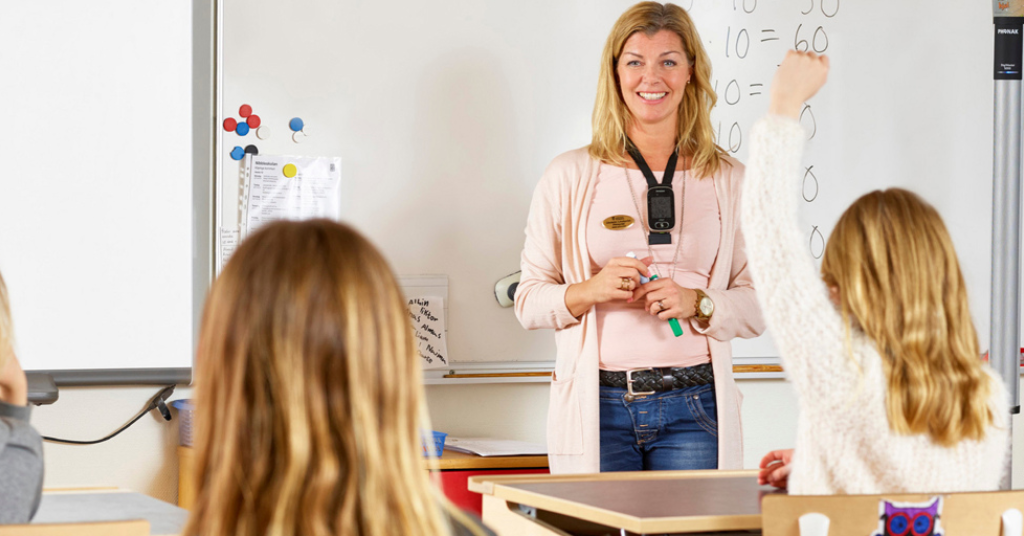
How to tell your deaf story for the world to see and hear
January 9, 2020
Tips for working with an employee who has hearing loss
January 10, 2020Teaching students with hearing loss

Teaching to find success for kids with hearing loss can be nothing short of wonderful.
Middle school principal Suzanne Webb is a former teacher and now, in her capacity as a school administrator, works with children with special needs. Throughout her career, she has learned methods for teaching students with hearing loss.
The task of any teacher, Webb says, is to ensure that students are accessing the curriculum, are successful, and are inspired to learn. At the beginning of each school year, any of Webb’s teachers who have a deaf or hard-of-hearing child in their classrooms usually meet with the former teacher of that student. The meeting allows teachers to share information about the student, and discuss which strategies previously worked in the classroom.
A teacher has to take a few extra steps to ensure a student with hearing loss has access to education. Teachers will want to learn about the mechanics of their student’s hearing loss. They’ll benefit by adding flexibility and a willingness to be creative in finding solutions to issues. And, of course, effective communication with the student is key.
Understanding what “Hearing Loss” means
Anyone who hasn’t had experience with hearing loss may not know exactly how a child’s hearing is affected. For example, a teacher new to hearing loss may not realize that a higher-pitched voice is often more difficult to hear, or that a beard makes it more difficult to read lips. A little research into the fundamentals of hearing loss can make it much easier for a teacher to understand the challenges students with hearing loss face in the classroom. A teacher can then address these issues with techniques such as lowering vocal tones, enunciating, and facing the student when speaking.
“A little research into the fundamentals of hearing loss can make it much easier for a teacher to understand the challenges students with hearing loss face in the classroom.”
Read more: How mild-moderate hearing loss often is overlooked in the classroom
In addition to learning what a given student with hearing loss can and can’t hear, understanding the student’s experience during school is also important. Listening is exhausting for someone with hearing loss. If you’ve ever been in a foreign country without speaking the language fluently, think about how you felt trying to make out meanings, translate signs, and comprehend language all day long.
Read more: How Roger helps with my children’s listening fatigue
Ellen Winkler, the mother of a seven-year-old with profound hearing loss, points out that travelers get breaks from that fatigue. However, kids with hearing loss don’t.
“Because of all the background noise, music, air conditioning, the hum of computers, hearing-impaired kids never get a break all day,” says Winkler, whose son, Jagger, has had bilateral cochlear implants since the age of 18 months.
In a teacher’s day-to-day life, keeping order in the classroom must often be the top priority, and sometimes teachers find themselves devoting a disproportionate amount of attention to students who are disruptive. Ellen Winkler says that Jagger’s even-keeled temperament means he sometimes misses out on the teacher’s attention.
“Jagger is the opposite of a squeaky wheel. It’s easy for some people not to give him that little bit of extra attention,” she says.
Even if children with hearing loss do not require behavior-related attention, they still require assistance. Teachers may want to set little reminders to regularly check in on their students with hearing loss throughout even the busiest of days. That small step can make a big difference in the child’s experience.
“She developed a set of hand-signal codes to determine whether his assistive devices were working. She downplayed it so other students didn’t think it was a big deal.”
Hearing loss in the classroom
Ellen Winkler and her husband experienced first-hand what makes a great teacher for students with hearing loss. In addition to understanding what Jagger could and couldn’t hear, his kindergarten teacher was willing to make changes in her classroom to benefit Jagger. She did this without making him feel abnormal.
“Jagger’s kindergarten teacher was incredible,” says Winkler. “She was willing to listen to us; to work extra to make sure he got what he needed.” Jagger’s teacher also implemented techniques that helped coordinate the use of assistive technology in the classroom. “She developed a set of hand-signal codes to determine whether his assistive devices were working,” says Winkler. “She downplayed it so other students didn’t think it was a big deal; it was just a normal part of the day.”
Debra Schrader, Educational Liaison for the House Research Institute, says teachers should ask students with hearing loss what’s working for them in the classroom, and why.
“Show me where you sit and tell me why you sit there,” she frequently asks students when discussing classroom strategies with them.
Schrader says that getting students to explain their reasoning helps them synthesize what they’re doing and think about why they’re doing it. Not only does this help both teacher and student in the classroom, but students can often use what they learn from the experience in other environments, too.
Communicating effectively
Educators can employ a handful of simple techniques in the classroom to make a big difference for their students with hearing loss:
1) Face the student when speaking
Make sure that your face is visible when speaking. Also, try to face the child with hearing loss as much as possible.
2) Use the buddy system
Another technique, suggested by Principal Webb, is the buddy system.
“We have students buddy up,” she says. “So a hearing student may work with someone who’s deaf or hard of hearing.”
This helps the student with hearing loss know where the class is in the lesson; it can also help a busy teacher.
3) Repeat yourself
Provide context and repetition, which is helpful not only to students with hearing loss but to other students as well. Announce what’s about to happen and recap what’s just taken place.
Assistive technologies can improve success in the classroom for students with hearing loss. They can increase access to sound and eliminate background noise. The most common of these is a remote microphone called the Phonak Roger Touchscreen Mic. This device uses Bluetooth technology to transmit sound directly to a child’s hearing technology. This solution is highly effective when it’s used correctly. It’s critical to ensure that the device is always on and working properly.
Ellen Winkler notes that without the remote microphone, her son Jagger can only hear about 75 percent of what’s going on in the classroom.
“With the remote microphone, he’s at about 98 percent,” she says.
It’s also important that the speaker, whether that’s the teacher, a guest speaker, or other students, wears the microphone. If the situation is not conducive to passing the microphone around the classroom, the teacher can get the same net result by repeating back what others are saying.
“Tommy says the answer is four,” a teacher could repeat.
Teachers can maximize the potential of assistive technologies by communicating its importance to other students, parents, and faculty, including substitute teachers and the administrative staff.
Finally, encouraging children to advocate for themselves is perhaps the single most important thing a teacher can do to help a student. If you create an environment in which a child with hearing loss is comfortable raising his or her hand to say, “Excuse me, teacher; I can’t hear you,” you will undoubtedly continue to change the lives of the students you teach.
Read more: 4 Tips for Teachers on Helping Deaf Students Succeed



